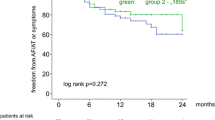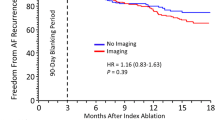Abstract
Purpose
The use of 3D mapping during cryoballoon pulmonary vein isolation (PVI) is optional with added cost but potential benefit in aiding vein identification, reducing fluoroscopy, and post-ablation testing. Data are limited evaluating procedural characteristics and outcomes in patients undergoing cryoballoon PVI with mapping vs. no mapping. In the present study, we compare procedural characteristics and recurrence-free rates in patients undergoing cryoballoon PVI among patients using CARTO®, NavX™, or no mapping system.
Methods
We evaluated a single center registry of patients undergoing cryoballoon PVI from 2013 to 2016, retrospectively. Patients undergoing a redo procedure or additional RF ablation were excluded. Baseline and procedural characteristics were compared among CARTO, NavX, and no mapping groups. Post-PVI patients were assessed for atrial arrhythmia recurrence after a 3-month blanking period. Recurrence was based on typical symptoms or ECG/event monitor evidence of atrial fibrillation (AF). Kaplan-Meier analysis was used to compare arrhythmia-free survival between groups.
Results
We included 432 patient procedures, 98 using mapping systems (45 NavX, 53 CARTO), and 334 without. When using the CARTO mapping system compared to NavX or no mapping, there were longer procedure times (168 vs.109 vs.115 min, p < 0.001) and LA dwell times (110 vs.81 vs.87 min, p < 0.001). Additionally, both CARTO and NavX, when compared to no mapping, had longer fluoroscopy times (32 vs.31 vs.26 min, p < 0.001). Overall, total ablation time was increased for patients without mapping systems compared to NavX. There were no significant differences in 1-year recurrence-free rates between CARTO, NavX, and no mapping groups (64.9 vs. 65.0 vs. 64.6%, p = 0.278).
Conclusion
Use of CARTO is associated with increased procedure and LA dwell times compared to NavX or no mapping. Mapping system use yielded longer fluoroscopy times without an improvement in atrial fibrillation recurrence. Given the additional cost of mapping, the role for routine use in cryoballoon PVI is unclear.

Similar content being viewed by others
References
Kuck K-H, Brugada J, Furnkkranz A, Metzner A, Ouyang F, Chun KRJ, et al. Cryoballoon or radiofrequency ablation for paroxysmal atrial fibrillation. N Engl J Med. 2016;374(23):2235–45. https://doi.org/10.1056/NEJMoa1602014.
Packer DL. Three-dimensional mapping in interventional electrophysiology: techniques and technology. J Cardiovasc Electrophysiol. 2005;16(10):1110–6. https://doi.org/10.1111/j.1540-8167.2005.50161.x.
KHAYKIN Y, Oosthuizen R, Zarnett L, Wulffhart ZA, Whaley B, Hill C, et al. CARTO-guided vs. NavX-guided pulmonary vein antrum isolation and pulmonary vein antrum isolation performed without 3-D mapping: effect of the 3-D mapping system on procedure duration and fluoroscopy time. J Interv Card Electrophysiol. 2011;30(3):233–40. https://doi.org/10.1007/s10840-010-9538-9.
Gepstein L, Hayam G, Ben-Haim SA. A novel method for nonfluoroscopic catheter-based electroanatomical mapping of the heart: in vitro and in vivo accuracy results. Circulation. 1997;95(6):1611–22. https://doi.org/10.1161/01.CIR.95.6.1611.
Wittkampf FH, Wever EF, Derksen R, Wilde AA, Ramanna H, Hauer RN, et al. LocaLisa: new technique for real-time 3-dimensional localization of regular intracardiac electrodes. Circulation. 1999;99(10):1312–7. https://doi.org/10.1161/01.CIR.99.10.1312.
Estner HL. Electrical isolation of pulmonary veins in patients with atrial fibrillation: reduction of fluoroscopy exposure and procedure duration by the use of a non-fluoroscopic navigation system (NavX(R)). Europace. 2006;8(8):583–7. https://doi.org/10.1093/europace/eul079.
Rotter M. Reduction of fluoroscopy exposure and procedure duration during ablation of atrial fibrillation using a novel anatomical navigation system. Eur Heart J. 2005;26(14):1415–21. https://doi.org/10.1093/eurheartj/ehi172.
Neumann T, Vogt J, Schumacher B, Dorszewski A, Kuniss M, Neuser H, et al. Circumferential pulmonary vein isolation with the cryoballoon technique. J Am Coll Cardiol. 2008;52(4):273–8. https://doi.org/10.1016/j.jacc.2008.04.021.
Sarabanda AV, Bunch TJ, Johnson SB, Mahapatra S, Milton MA, Leite LR, et al. Efficacy and safety of circumferential pulmonary vein isolation using a novel cryothermal balloon ablation system. J Am Coll Cardiol. 2005;46(10):1902–12. https://doi.org/10.1016/j.jacc.2005.07.046.
Klein G, Oswald H, Gardiwal A, Lüsebrink U, Lissel C, Yu H, et al. Efficacy of pulmonary vein isolation by cryoballoon ablation in patients with paroxysmal atrial fibrillation. Heart Rhythm. 2008;5(6):802–6. https://doi.org/10.1016/j.hrthm.2008.02.014.
Sporton SC, Earley MJ, Nathan AW, Schilling RJ. Electroanatomic versus fluoroscopic mapping for catheter ablation procedures: a prospective randomized study. J Cardiovasc Electrophysiol. 2004;15(3):310–5. https://doi.org/10.1111/j.1540-8167.2004.03356.x.
Author information
Authors and Affiliations
Contributions
Emily Guhl: conception, design, analysis, and drafting of the manuscript, Evan Adelstein: manuscript revision for important intellectual content, Samir Saba: manuscript revision for important intellectual content, Andrew Voigt: manuscript revision for important intellectual content, Norman Wang: manuscript revision for important intellectual content, Sandeep Jain: conception, design, and drafting of the manuscript, manuscript revision for important intellectual content and final approval of the manuscript.
Corresponding author
Ethics declarations
Conflicts of interest
We disclose the following relationships with industry: Samir Saba as a consultant to Boston Scientific and with a research grant from Boston Scientific (significant), Medtronic (modest), and St. Jude Medical (modest). Sandeep Jain with research support and consultant Medtronic (modest). Evan Adelstein with research support from Medtronic (minimal). Norman Wang with research support from Boston Scientific (minimal) and Andrew Voigt as research trial investigator for Abbott. The remaining authors have no conflicts of interest to disclose.
Rights and permissions
About this article
Cite this article
Guhl, E.N., Adelstein, E., Voigt, A. et al. Impact of 3D mapping on procedural characteristics and outcomes in cryoballoon pulmonary vein isolation for atrial fibrillation. J Interv Card Electrophysiol 51, 71–75 (2018). https://doi.org/10.1007/s10840-017-0304-0
Received:
Accepted:
Published:
Issue Date:
DOI: https://doi.org/10.1007/s10840-017-0304-0




